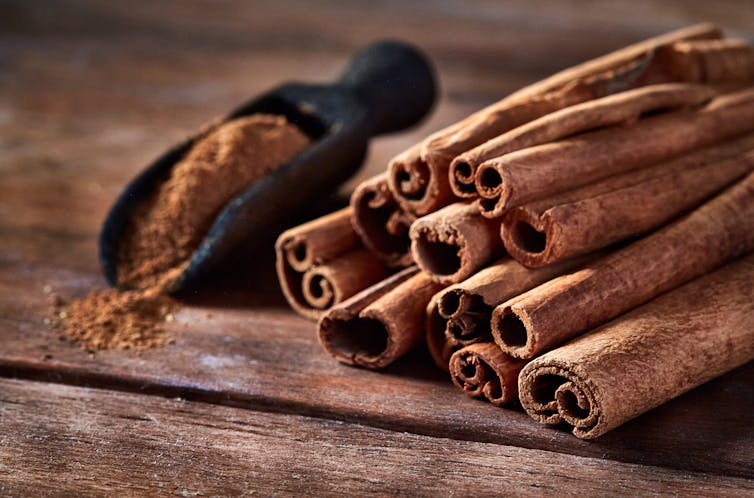Spices bring up feelings of comfort, cultural belonging and holidays. They can make our homes smell amazing and our food taste delicious. They can satisfy our cravings, expand our culinary horizons and help us eat things that we might normally dislike. Spices have health-enhancing properties and, in medicine, have been used to heal people since the ancient times.
Recently, however, spices have been getting a bad rep.
In September 2024, Consumer Reports, a nonprofit organization created to inform consumers about products sold in the U.S., investigated more than three dozen ground cinnamon products and found that 1 in 3 contained lead levels above 1 part per million, enough to trigger a recall in New York, one U.S. state that has published guidelines for heavy metals in spices.
The Food and Drug Administration issued three alerts throughout 2024, warning consumers about lead in certain brands of cinnamon products. Such notices rightfully put consumers on alert and have people wondering if the spice products they buy are safe – or not.
As an environmental epidemiologist with training in nutritional sciences, I have investigated the relationship between nutritional status, diets and heavy metal exposures in children.
There are several things consumers should be thinking about when it comes to lead – and other heavy metals – in cinnamon.
Why is lead found in cinnamon?
Most people are familiar with cinnamon in two forms – sticks and ground spice. Both come from the dried inner bark of the cinnamon tree, which is harvested after a few years of cultivation. For the U.S. market, cinnamon is largely imported from Indonesia, Vietnam, Sri Lanka, India and China.
One way that lead could accumulate in cinnamon tree bark is when trees are cultivated in contaminated soil. Lead can also be introduced in cinnamon products during processing, such as grinding.
When ground cinnamon is prepared, some producers may add lead compounds intentionally to enhance the weight or color of the product and, thus, fetch a higher sale price. This is known as “food adulteration,” and products with known or suspected adulteration are refused entry into the U.S.
However, in the fall of 2023, approximately 600 cases of elevated blood lead levels in the U.S., defined as levels equal to or above 3.5 micrograms per deciliter – mostly among children – were linked to the consumption of certain brands of cinnamon apple sauce. The levels of lead in cinnamon used to manufacture those products ranged from 2,270 to 5,110 parts per million, indicating food adulteration. The manufacturing plant was investigated by the FDA.

Dong Jianghui/Xinhua via Getty Images
More broadly, spices purchased from vendors in the U.S. have lower lead levels than those sold abroad.
There is some evidence that cinnamon sticks have lower lead levels than ground spice. Lead levels in ground cinnamon sold in the U.S. and analyzed by Consumer Reports ranged from 0.02 to 3.52 parts per million. These levels were at least 1,500 times lower than in the adulterated cinnamon.
There are no federal guidelines for lead or other heavy metals in spices. New York state has proposed even stricter guidelines than its current level of 1 part per million, which would allow the New York Department of Agriculture and Markets to remove products from commerce if lead levels exceed 0.21 parts per million.
What does it mean that ‘the dose makes the poison’?
The current FDA guideline on daily intake of lead from diets overall is to limit lead intake to 2.2 micrograms per day for children. For women of reproductive age, this value is 8.8 micrograms.
The lead dose we are exposed to from foods depends on the level of lead in the food and how much of that food we eat. Higher doses mean more potential harm. The frequency with which we consume foods – meaning daily versus occasionally – also matters.
For spices like cinnamon, the amount and frequency of consumption depends on cultural traditions and personal preference. For many, cinnamon is a seasonal spice; others use it year-round in savory dishes or sauces.
Cinnamon is beloved in baked goods. Take a cinnamon roll recipe calling for 1.5 tablespoons (slightly less than 12 grams) of the spice. If a recipe yields 12 rolls, each will have around 1 gram of cinnamon. In the Consumer Reports investigation, some cinnamon products were classified as “okay to use” or “best to use.”
The highest value of lead in cinnamon products in the “okay to use” category was 0.87 parts per million, and in the “best to use” category, it was 0.15 parts per million. A child would have to consume 2.5 or more rolls made with the “okay to use” cinnamon to exceed the FDA guideline on limiting lead intake from foods to 2.2 micrograms per day, assuming that no other food contained lead. To exceed this guideline with “best to use” cinnamon, a child would have to eat 15 or more rolls.

Helen Camacaro/Moment via Getty Images
Can cinnamon contribute to elevated blood lead levels?
Because of lead’s effects on development in early life, the greatest concern is for exposure in young children and pregnant women. Lead is absorbed in the small intestine, where it can latch onto cellular receptors that evolved to carry iron and other metals.
The impact of a contaminated spice on a person’s blood lead level depends on the dose of exposure and the proportion of lead available for intestinal absorption. For several spices, the proportion of available lead was 49%, which means that about half of the lead that is ingested will be absorbed.
Lead absorption is higher after a fast of three hours or more, and skipping breakfast may contribute to higher blood lead levels in children.
People who have nutritional deficiencies, such as iron deficiency, also tend to absorb more lead and have higher blood lead levels. This is because our bodies compensate for the deficiency by producing more receptors to capture iron from foods. Lead takes advantage of the additional receptors to enter the body. Young children and pregnant women are at higher risk for developing iron deficiency, so there is good reason for vigilance about lead in the foods they consume.
Studies show that among children with lead poisoning in the U.S., contaminated spices were one of several sources of lead exposure. Studies that estimate blood lead levels from statistical models suggest that consuming 5 micrograms of lead or more from spices daily could substantially contribute to elevated blood lead levels.
For occasional or seasonal consumption, or lower levels of contamination, more research is needed to understand how lead in spices would affect lead levels in the blood.
For people who have other sources of lead in their homes, jobs or hobbies, additional lead from foods or spices may matter more because it adds to the cumulative dose from multiple exposure sources.
How to test for elevated blood lead levels
The Centers for Disease Control and Prevention recommends that children at risk for lead exposure get a blood lead test at 1 and 2 years of age. Older children can also get tested. Finger-prick screening tests are often available in pediatric offices, but results may need to be confirmed in venous blood if the screening result was elevated.
Adults in the U.S. are not routinely tested for lead exposure, but concerned couples who plan on having children should talk to their health care providers.
What to consider when using or buying cinnamon or other spices
If the product is on an FDA Alert or the Consumer Reports “don’t use” list, discard it.
Other questions to consider are:
- Does your household use spices frequently and in large amounts?
- Do young children or pregnant women in your household consume spices?
- Do you typically consume spices on breakfast foods or beverages?
If the answer to any of these questions is yes, then buy good-quality products, from large, reputable sellers. Think about using cinnamon sticks if possible.
And continue to enjoy spices!


